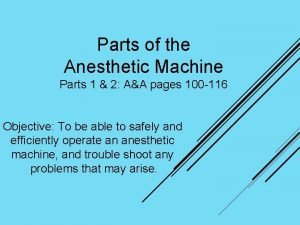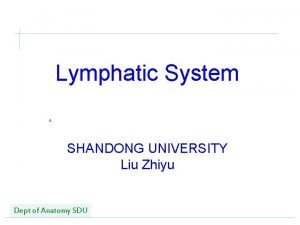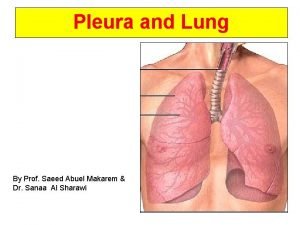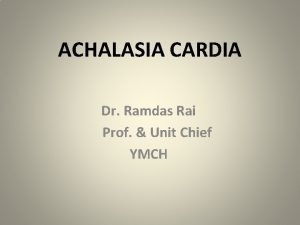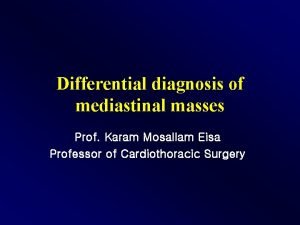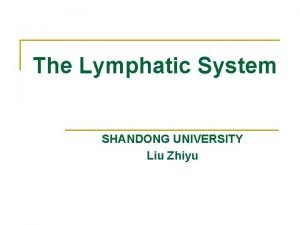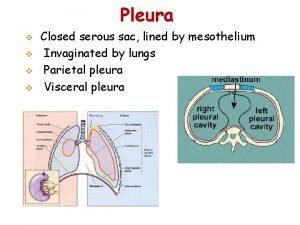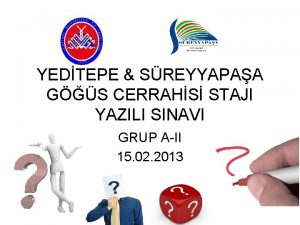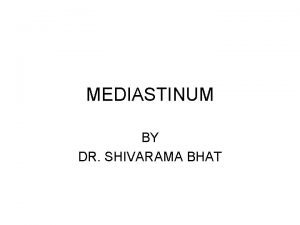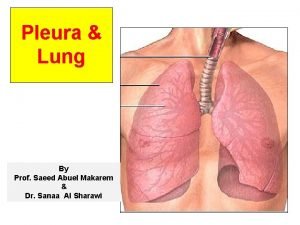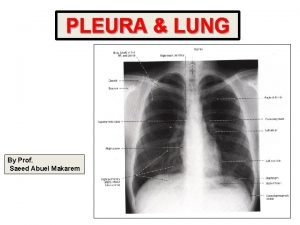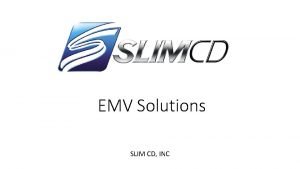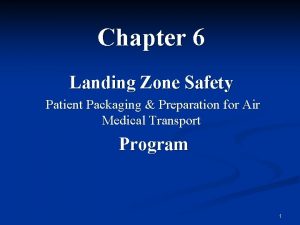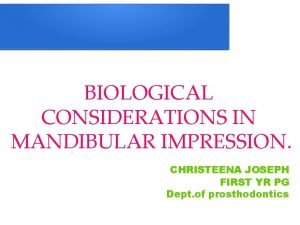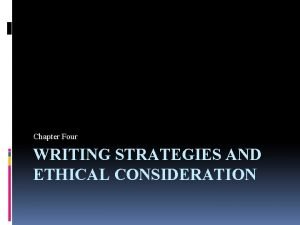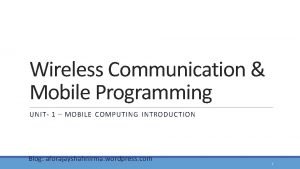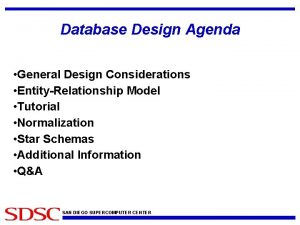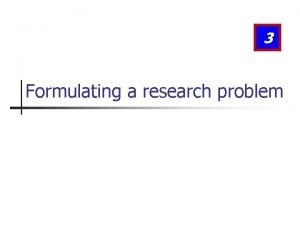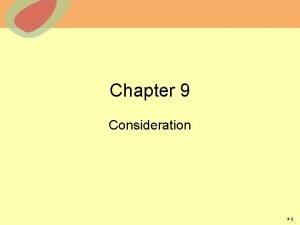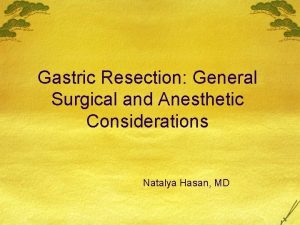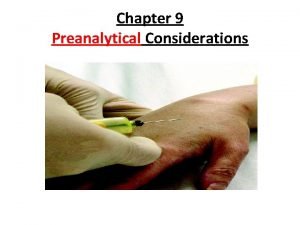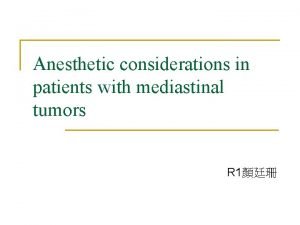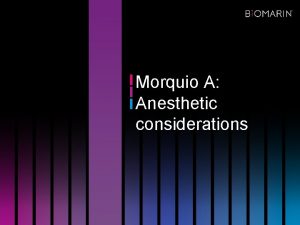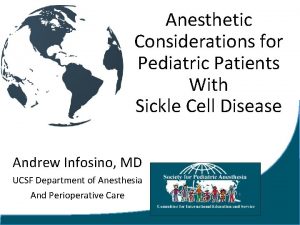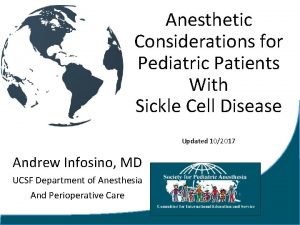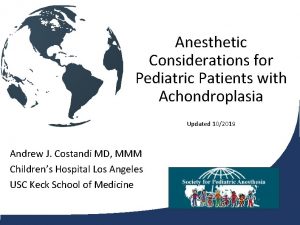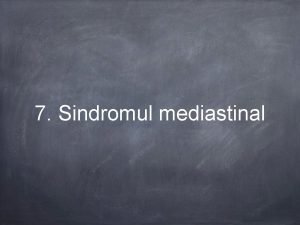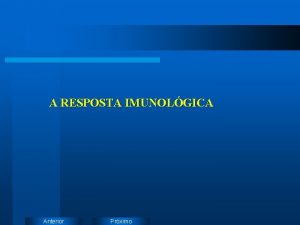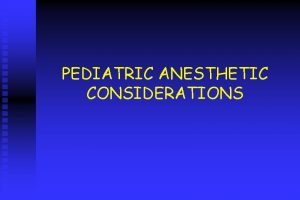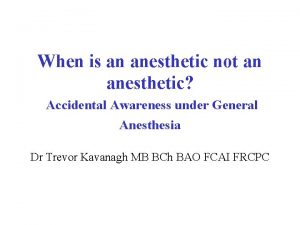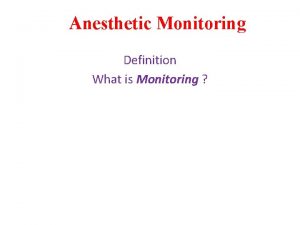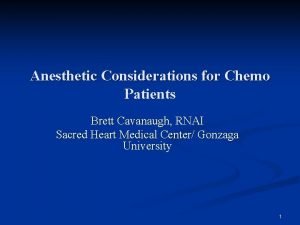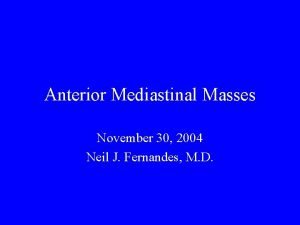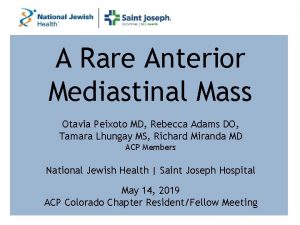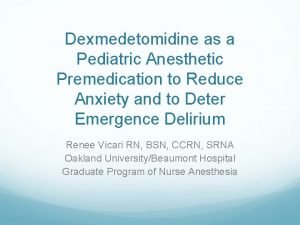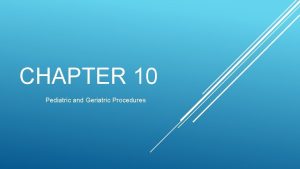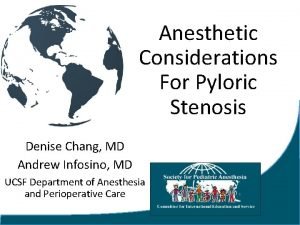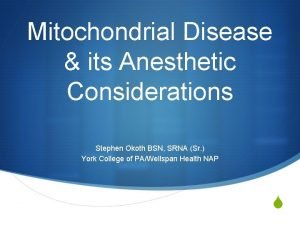Anesthetic Considerations for Pediatric Patients with Anterior Mediastinal




































- Slides: 36

Anesthetic Considerations for Pediatric Patients with Anterior Mediastinal Masses (AMM) Updated 9/2019 Vasili Chernishof, M. D. Carl Lo, M. D. Children’s Hospital Los Angeles

Disclosures No relevant financial relationships to report

Learning Objectives: • Identify anatomical and physiological perturbations that occur with mediastinal masses • Identify perioperative complications likely to occur in these patients and discuss their management • Discuss pre-operative testing used for anesthetic planning and risk stratification • Present anesthesia techniques helpful for management of anterior mediastinal mass

Introduction Signs and Symptoms Transient decrease in blood pressure Airway obstruction Complete cardiovascular collapse Death Perioperative complications are estimated to occur during 9% to 20% of anesthetic procedures. 1, 2 The differences between adult and pediatric populations relate to the histology, location, and symptomatology of the mediastinal masses. 3

Anatomy Most masses in the pediatric population are found in the anterior compartment, which are associated with increased perioperative risks. 4 -6

Mediastinal Masses Anterior Middle Posterior Benign Malignant *Thymoma Thymic carcinoma Adenopathy *Lymphoma *Neurofibroma Neuroblastoma Cysts Esophageal Cancer Schwannoma Thyroid Cystic hygroma Thyroid carcinoma Thymic cyst Seminoma Thymic hyperplasia Mixed Germ Cell Lymphoma Esophageal mass Vascular structures Hiatus hernia Thyroid carcinoma Metastasis Chemodectoma

Anterior Mediastinal Mass (AMM) Children (%) Adults (%) Lymphomas 45 23 Germ cell tumors 24 14 Thymomas 16 47 Others 15 16 T-cell lymphoblastic leukemia, non-Hodgkin’s lymphoma, and neurogenic tumors have an increased incidence, as well as, increased risk of perioperative complications in children. 4, 7, 12

Physiology Cardiopulmonary symptoms can be explained by compression of airway, cardiac, or major vessels by the mass.

Physiology Hemodynamic compromise Superior Vena Cava Mass Compression Right Cardiac Chambers Left Ventricular Preload Pulmonary Arteries Pulmonary Veins Cardiac Output

Physiology Mass Compression Hypoxemia Superior Vena Cava Right Cardiac Chambers Pulmonary Arteries Pulmonary Veins Pulmonary Perfusion RV Failure Hypoxemia

Physiology Hypoxemia Superior Vena Cava Mass Compression Right Cardiac Chambers Pulmonary Arteries Pulmonary Veins Pulmonary Edema Cardiac Output Hypoxemia

Physiology Gravity Worsening V/Q mismatch Increased Intrathoracic Pressure Airway Collapse Supine position

Signs and Symptoms Airway Cardiovascular Constitutional Shortness of breath Stridor Pleural effusion Accessory muscle use Orthopnea Cough Dyspnea Hoarseness Hx of respiratory arrest Cyanosis Syncope Tachycardia SVC syndrome Upper body edema Jugular venous distension arrhythmias Weight loss Fever Night sweats Dependent on size, location, and the rate of growth Systemic effects of the tumor Thyroid function abnormalities Myasthenic Crisis

Signs and Symptoms As compared to adults, children experience more signs and symptoms • AMM tend to be more central • More likely to compress on the softer airway and vascular structures • More likely to be malignant and grow/infiltrate at a faster rate • Smaller intrathoracic volumes may not be able to accommodate the mass as easily

Pre-operative testing I. Anatomic Testing • Anterior-posterior and lateral chest X-rays • CT scan • MRI • Positron Emission tomography • Angiography • Echocardiography

Pre-operative testing II. Physiologic Testing • Complete blood count, electrolytes • Pulmonary function tests • Transthoracic echocardiography (ECHO) • Thyroid scan

Pre-operative testing III. Tumor markers • Uric acid, LDH, β-HCG, α-fetoprotein, thyroid function test • Flow cytometry • Lumbar puncture • Bone marrow aspirate and biopsy

Computed tomography Scan It is imperative that patients undergo a CT scan to further delineate the exact location of the mass, as well as the degree of airway and cardiovascular structure compression.

Transthoracic echocardiography ECHO done in the supine position will evaluate cardiovascular compression, reduction of pulmonary blood flow, cardiac output, and pericardial tamponade physiology.

Risk Stratification Low Risk Signs Intermediate Risk High Risk No airway, cardiac, Mild tracheal or vascular compression (<70%) Tracheal compression (>70%) No bronchial compression Bronchial compression Great vessel compression Tamponade physiology Symptoms None Mild to moderate Postural Orthopnea Stridor Cyanosis

Anesthetic Management Multidisciplinary team Surgery Radiology Oncology Critical Care Anesthesiology Consider referring to a high-level pediatric surgery center

Anesthesia Type Local Anesthesia +/- Sedation General Anesthesia Procedures Extrathoracic lymph node biopsy Percutaneous needle aspiration of mass, pericardial fluid, or pleural fluid Open biopsy or resection of the mass Thoracoscopic biopsy of the mass

Undiagnosed mediastinal mass Consult pediatrics, hematology/oncology, anesthesiology, PICU, radiation oncology, pediatric surgery CBC, LP, bone marrow biopsy/aspiration Chest X-ray, CT scan, ECHO Airway or cardiovascular obstruction Biopsy under local anesthesia Tracheostomy, CPB available No Airway or cardiovascular obstruction Biopsy under local anesthesia NOT feasible Biopsy Radiation therapy* Local Anesthetic OR General Anesthesia *If radiation therapy is NOT available, proceed with multidisciplinary operative plan

Anesthesia Techniques Volatile Agents Ketamine Positive pressure ventilation? Dexmedetomidine Muscle relaxation? Propofol

Airway management Posture Spontaneous Respiration Airway Stenting CPB • Induce in sitting position • Change supine position to lateral or prone • Inhalational induction • Intravenous induction • Awake fiberoptic intubation • • Long ETT Double-lumen ETT Rigid bronchoscope Insertion of tracheobronchial stents • Commenced under local anesthesia before induction • Vessels prepared under local anesthesia GA

Vascular involvement SVC Syndrome Intraoperative Hemorrhage It is prudent to place a large bore intravenous cannula in the lower body, preferably in the femoral vein, to facilitate transfusion if the SVC is breached surgically.

Intraoperative Considerations Large-bore IV X 2 (SVC Syndrome: place in the lower limbs) Blood in OR Arterial line (left radial artery) +/- CVP/PA

Managing Intraoperative Complications Rescue position Rigid bronchoscopy Cardiopulmonary bypass Emergent sternotomy

Postoperative Considerations Pain management Parenteral opioids +/- Epidural catheter +/- Peripheral nerve block

Conclusion H&P CT Scan ECHO Location Timing Type GA vs. Local +/sedation Patient Safety Multidisciplinary team Patient, Family

References: 1. Hack HA, Wright NB, Wynn RF. The anaesthetic management of children with anterior mediastinal masses. Anaesthesia. 2008; 63: 837 -846. 2. Bechard P, Letourneau L, Lacasse Y, Cote D, Bussieres JS. Perioperative cardiorespiratory complications in adults with mediastinal mass: incidence and risk factors. Anesthesiology. 2004; 100: 826 -834; discussion 5 A. 3. Takeda SI, Miyoshi S, Akashi A, et al. Clinical spectrum of primary mediastinal tumours: a comparison of adult and pediatric populations at a single Japanese institution. J Surg Oncol 2003; 83(1): 24– 30.

References: 4. Anghelescu DL, Burgoyne LL, Liu T, et al. Clinical and diagnostic imaging findings predict anesthetic complications in children presenting with malignant mediastinal masses. Paediatr Anaesth. 2007; 17: 10901098. 5. King RM, Telander RL, Smithson WA, Banks PM, Han MT. Primary mediastinal tumors in children. J Pediatr Surg. 1982; 17: 512 -520. 6. Grosfeld JL, Skinner MA, Rescorla FJ, West KW, Scherer LR III. Mediastinal tumors in children: experience with 196 cases. Ann Surg Oncol. 1994; 1: 121 -127.

References: 7. King DR, Patrick LE, Ginn-Pease ME, Mc. Coy KS, Klopfenstein K. Pulmonary function is compromised in children with mediastinal lymphoma. J Pediatr Surg. 1997; 32: 294 -299; discussion 299 -300. 8. Blank RS, de Souza DG. Anesthetic management of patients with an anterior mediastinal mass: continuing professional development. Can J Anaesth. 2011; 58: 853859, 860 -867. 9. Pearson JK. Pediatric anterior mediastinal mass: a review article. Semin Cardiothorac Vasc Anesth. 2015; 3: 248– 54.

References: 10. Ng A, Bennett J, Bromley P, Davies P, Morland B. Anaesthetic outcome and predictive risk factors in children with mediastinal tumours. Pediatr Blood Cancer. 2007; 48: 160 -164. 11. Lin C. M. , Hsu J. C. Anterior mediastinal tumour identified by intraoperative transesophageal echocardiography. Can J Anaesth, 2001. 48(1): 78 -80. 12. Azarow KS, Pearl RH, Zurcher R, et al. Primary mediastinal masses. A comparison of adult and pediatric populations. J Thorac Cardiovasc Surg 1993; 106: 67– 72.

References: 13. Schmidt B, Massenkeil G, Matthias J, et al. Temporary tracheobronchial stenting in malignant lymphoma. Ann Thorac Surg 1999; 67: 1448– 50. 14. Abel M, Eisenkraft JB. Anesthetic implications of myasthenia gravis. Mt Sinai JMed 2002; 69(1– 2): 31– 7. 15. Chevalley C, Spiliopoulos A, de Perrot M, et al. Perioperative medical management and outcome following thymectomy for myasthenia gravis. Can J Anaesth 2001; 48: 446– 51. 16. Gothard JW. Anesthetic considerations for patients with anterior mediastinal masses. Anesthesiol Clin. 2008; 26(2): 305– 14. doi: 10. 1016/j. anclin. 2008. 01. 002.

References: 17. Neuman GG, Weingarten AE, Abramowitz RM, et al. The anesthetic management of the patient with an anterior mediastinal mass. Anesthesiology 1984; 60: 144– 7. 18. Hammer G. B. Anaesthetic management for the child with a mediastinal mass. Paediatric Anaesthesia. 2004; 14(1): 95 – 97. doi: 10. 1046/j. 1460 -9592. 2003. 01196. 19. Green SM, Rothrock SG: Transient apnea with intramuscular ketamine. Am J Emerg Med. 15: 440 -441 1997. 20. 747 Koroglu A, Teksan H, Sagir O, et al. : A comparison of the sedative, hemodynamic, and respiratory effects of dexmedetomidine and propofol in children undergoing magnetic resonance imaging. Anesth Analg.
 Anesthetic, pungent, sweet
Anesthetic, pungent, sweet Vaporizer machine parts
Vaporizer machine parts Lymphatic drainage of umbilicus
Lymphatic drainage of umbilicus Lung pleura
Lung pleura Achalasia cardia
Achalasia cardia Poosterior
Poosterior Glans penis lymph drainage
Glans penis lymph drainage Costodiaphragmatic recess
Costodiaphragmatic recess Mediastinal flatter
Mediastinal flatter Parietal and visceral pericardium
Parietal and visceral pericardium Aortic impression lung
Aortic impression lung Pleural adhesions
Pleural adhesions Practical considerations for costume design might include
Practical considerations for costume design might include Emv kiosk considerations
Emv kiosk considerations Collaboration design considerations
Collaboration design considerations Mechanical considerations of transmission line
Mechanical considerations of transmission line Azure landing zone considerations
Azure landing zone considerations Eswl anesthesia considerations
Eswl anesthesia considerations Ethical considerations examples
Ethical considerations examples Fluid intake pdhpe
Fluid intake pdhpe Alveololingual sulcus parts
Alveololingual sulcus parts Writing strategies and ethical considerations
Writing strategies and ethical considerations Pricing considerations and approaches
Pricing considerations and approaches What are the general considerations in machine design?
What are the general considerations in machine design? Design considerations for mobile computing
Design considerations for mobile computing Principle of fpd
Principle of fpd Database design considerations
Database design considerations Considerations in selecting a research problem
Considerations in selecting a research problem Considerations examples
Considerations examples Dogso considerations
Dogso considerations Natalya hasan
Natalya hasan Basal state specimen
Basal state specimen Hach wims
Hach wims Data warehouse considerations
Data warehouse considerations Appendices sample
Appendices sample Tax considerations for setting up a new business
Tax considerations for setting up a new business Anatomical considerations
Anatomical considerations

